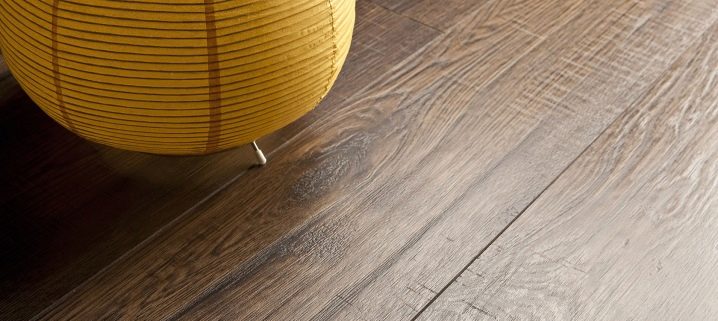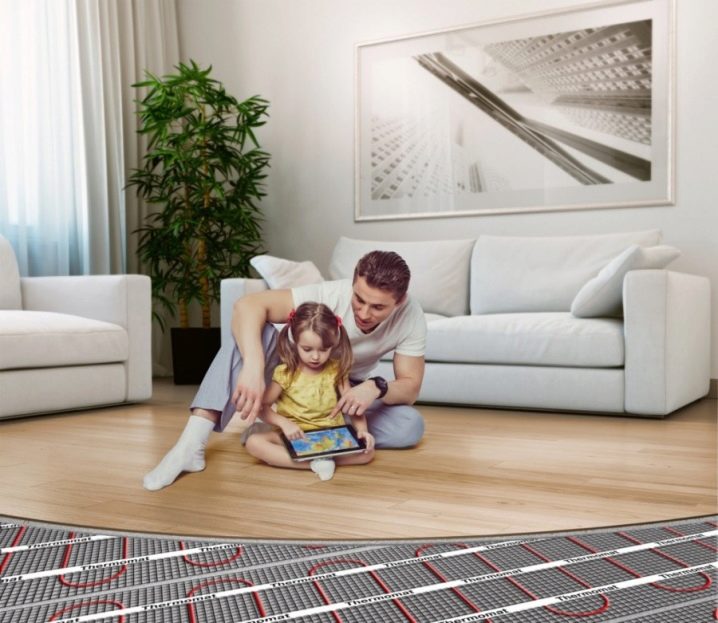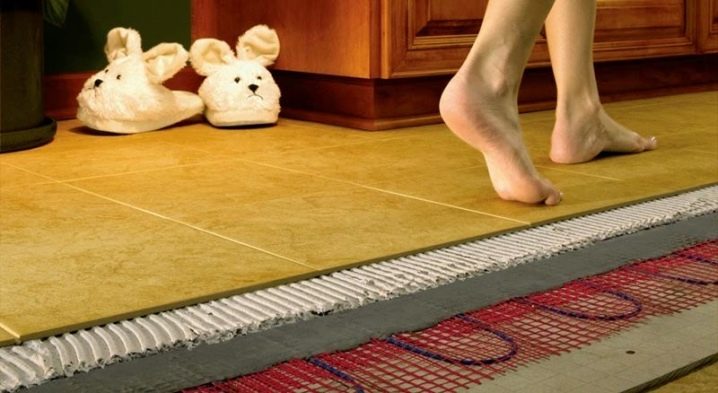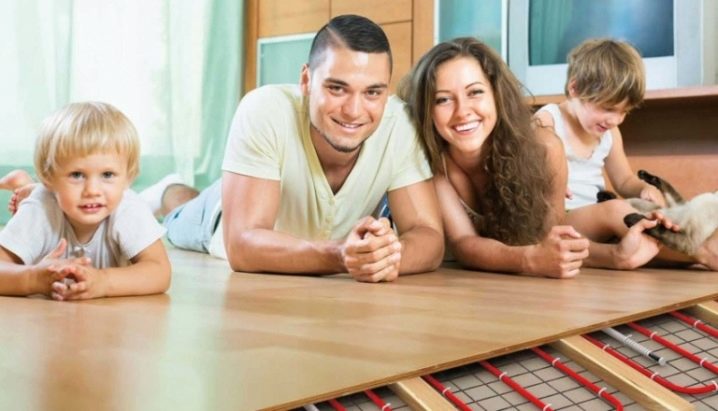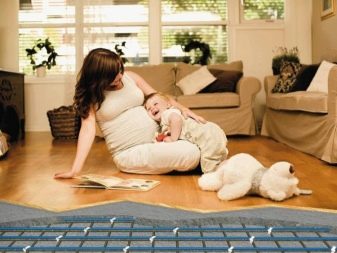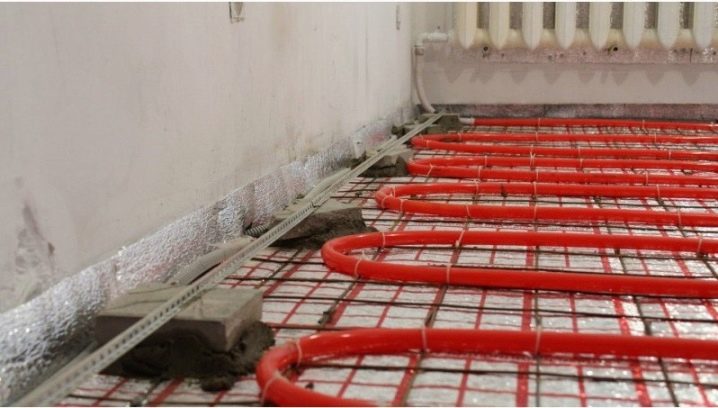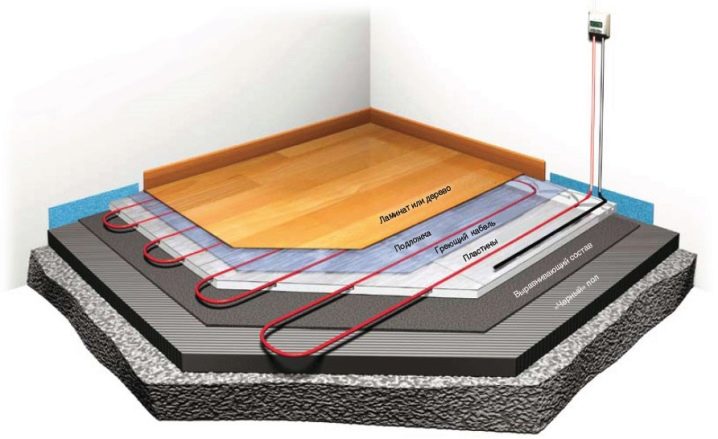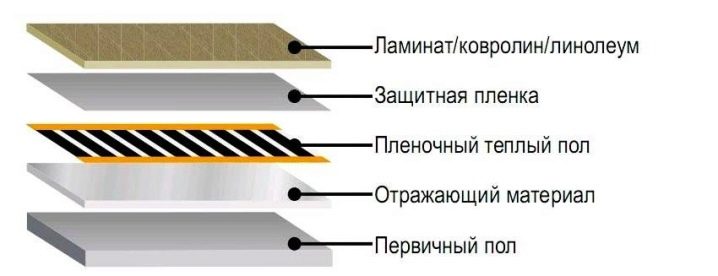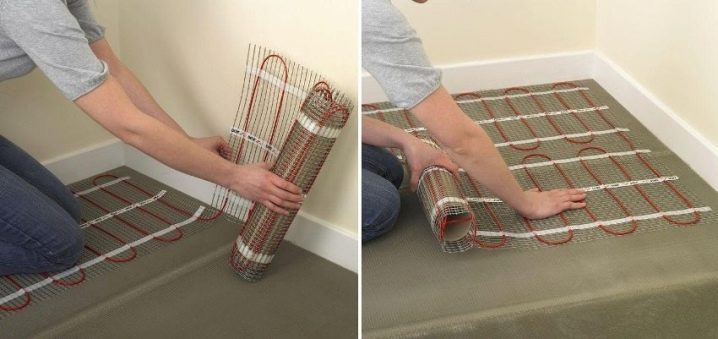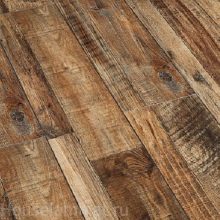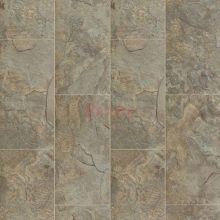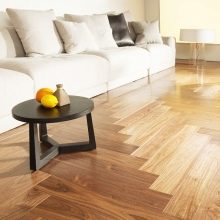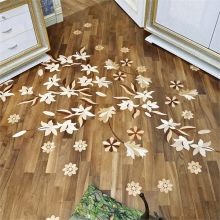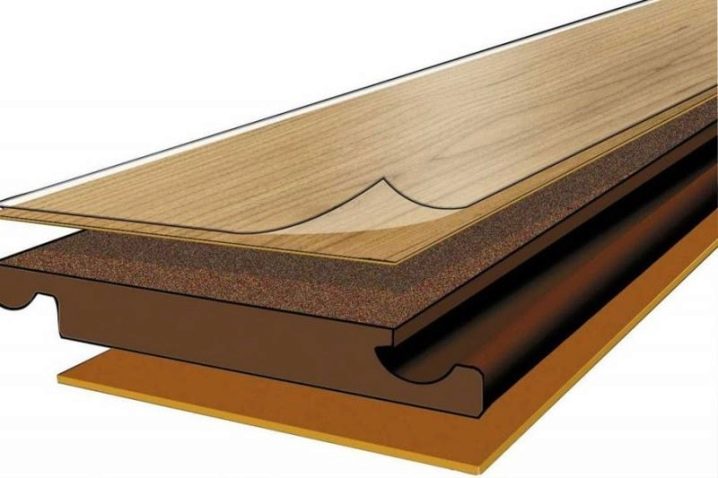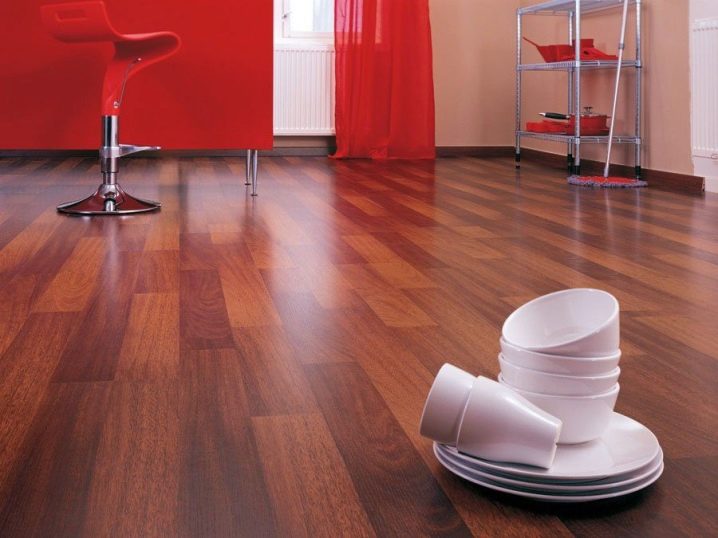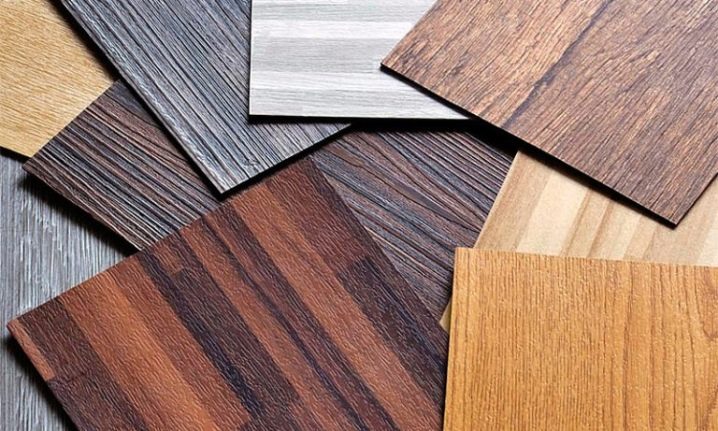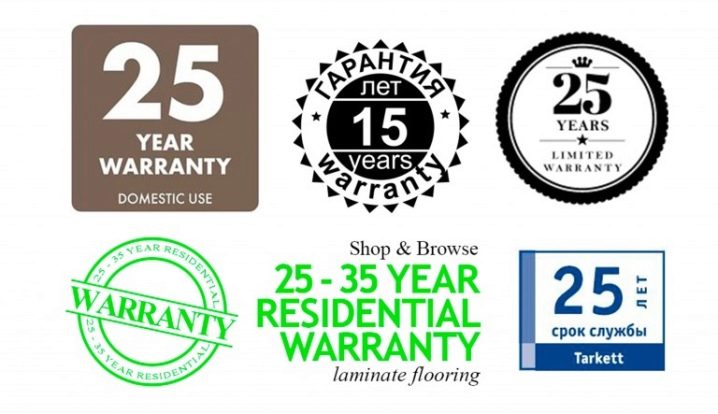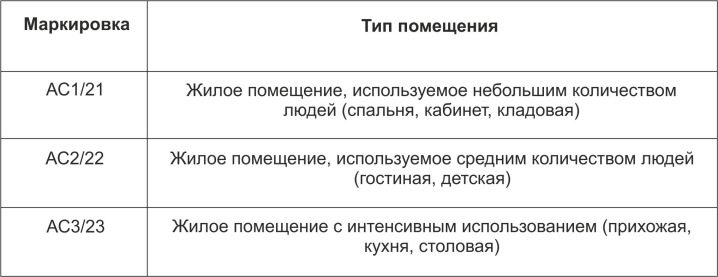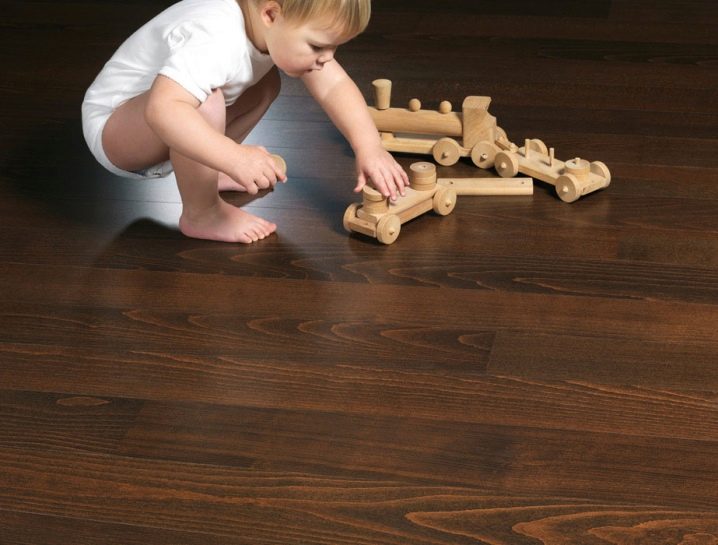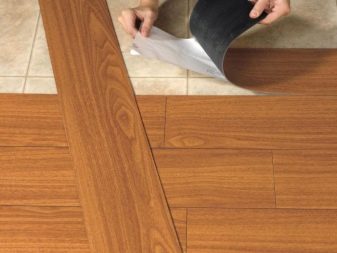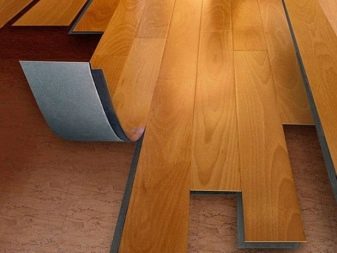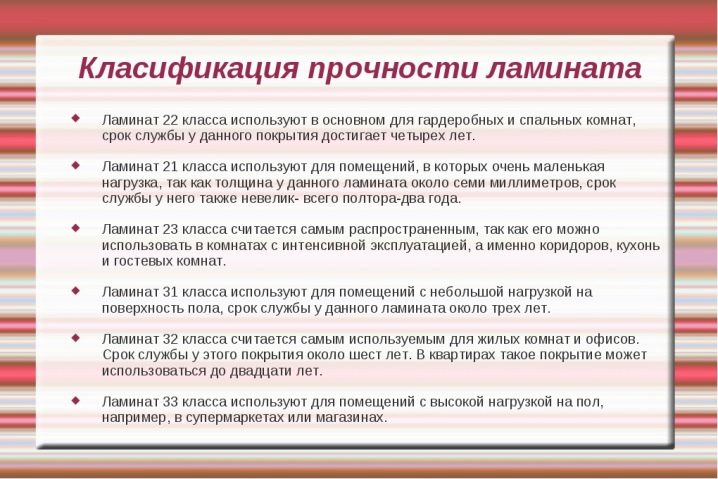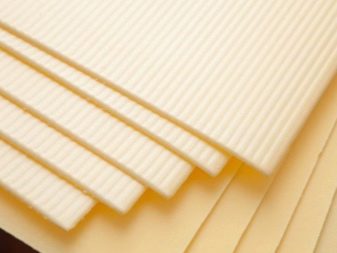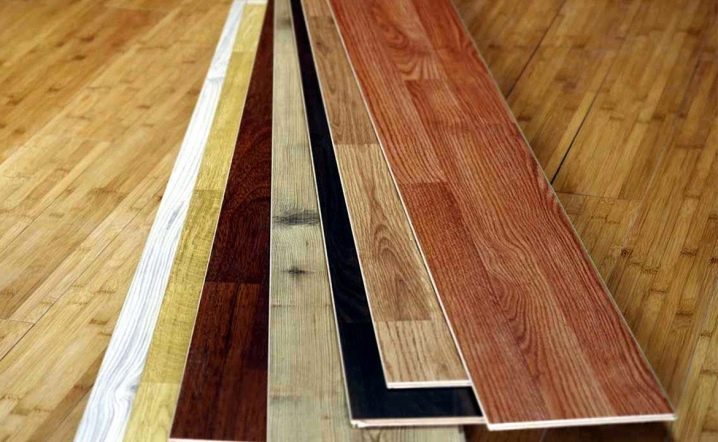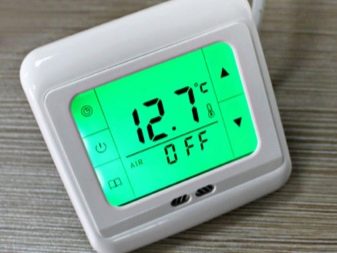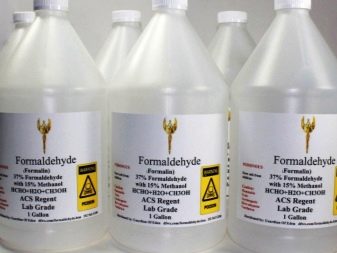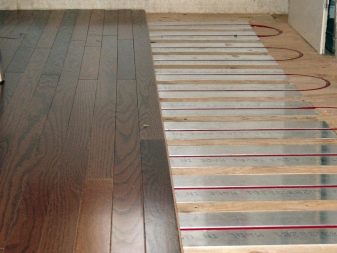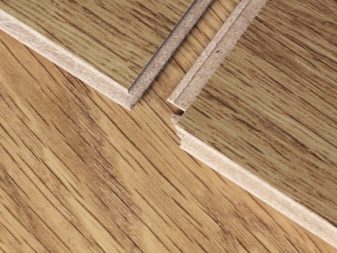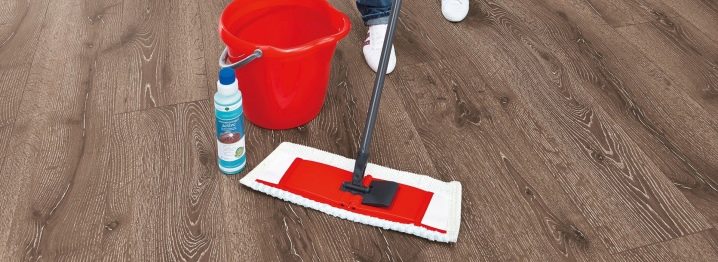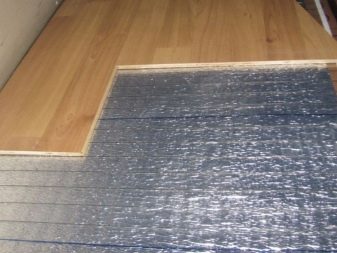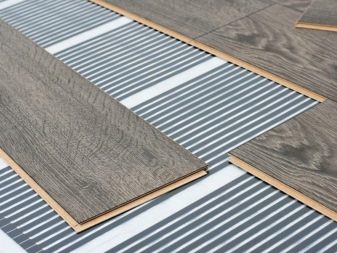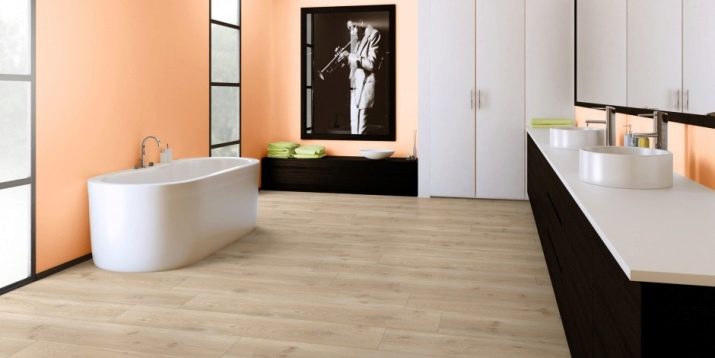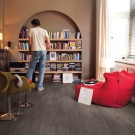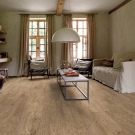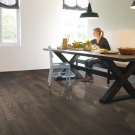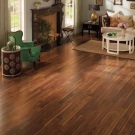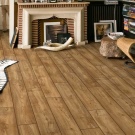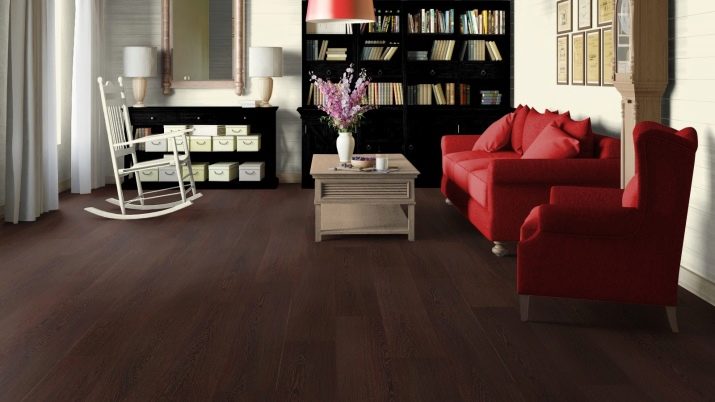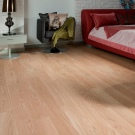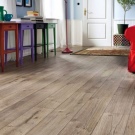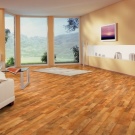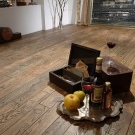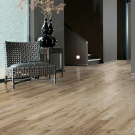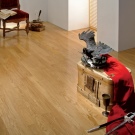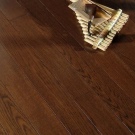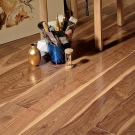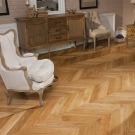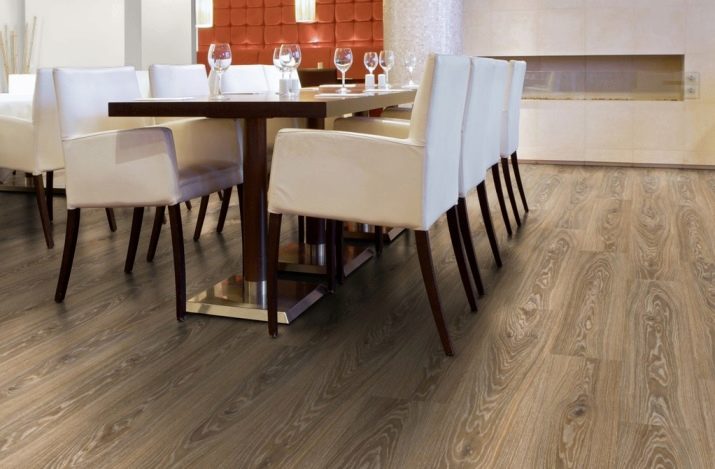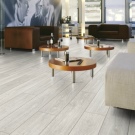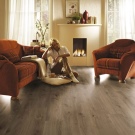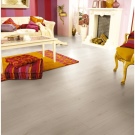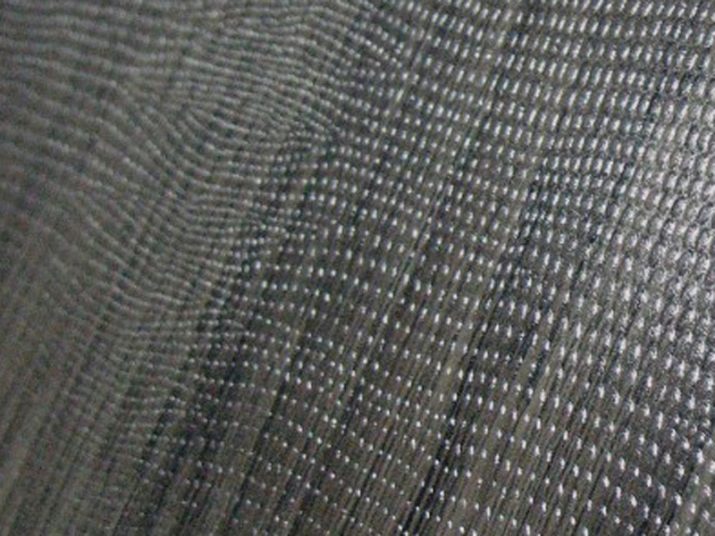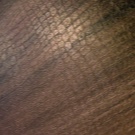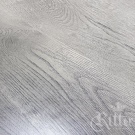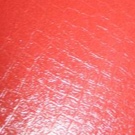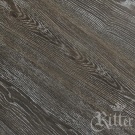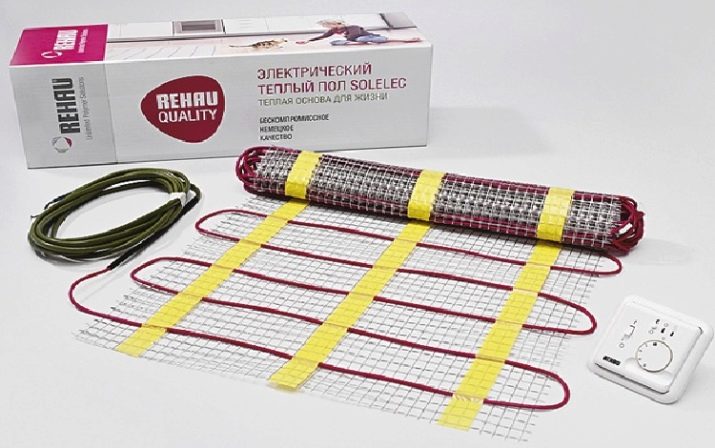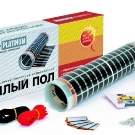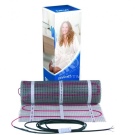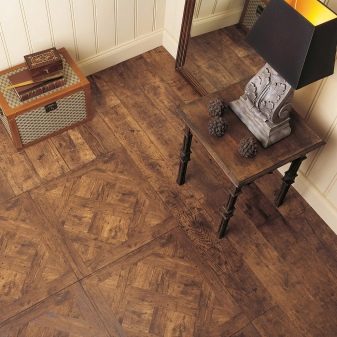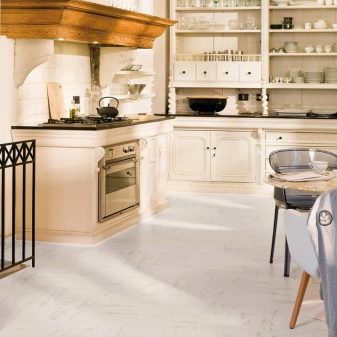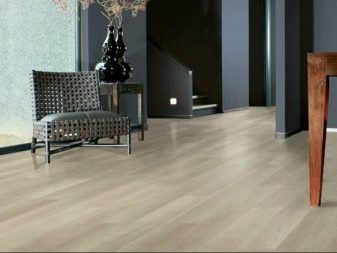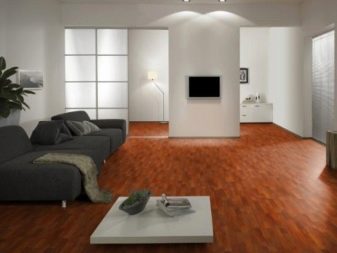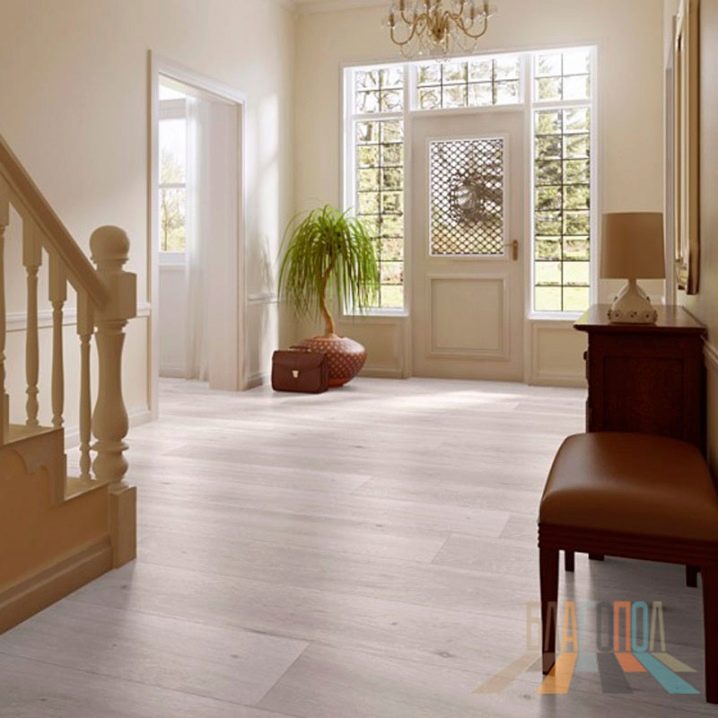Choosing a warm floor under the laminate

Walking on a smooth flooring is one of the most pleasant sensations. Covering a comfortable temperature will make these sensations even more pleasant: in the summer it will be cool, and in the winter - warm. Among the popular materials for finishing the floor is leading a beautiful, smooth, pleasant to the touch laminate.
But by itself, this material is quite cold, and in the winter it requires additional measures for warming, especially if there are children in the house.
To solve this problem once and for all, you should choose a warm floor under the laminate.
Advantages and disadvantages
Heated floor or floor "heated" was widespread no more than ten years ago. Until that time, he rather belonged to the exotic, and few could afford to improve this kind in the house. Today it is a common phenomenon and in fact the only way to achieve a comfortable temperature in cold apartments and country houses.
The popularity of the warm floor provide numerous advantages:
- This is a practical alternative to all kinds of heaters and heat fans, which unevenly give off heat to the room and heat rather than the floor, but all the air, which leads to stuffiness and dryness.
- Most modern floor heating systems evenly distribute it over the entire surface area. At the same time, if the heat of radiators for space heating is not enough, the heating system successfully replaces any electrical appliances.
- On warm and hard flooring, you can walk without socks and slippers, which is not only pleasant, but also very useful for several reasons.
- In children and adolescents, the bones, muscles, and ligaments of the feet are correctly formed. These include the prevention of diseases, flat-footedness, clubfoot and other defects, and the guarantee of the formation of a beautiful, regular foot shape;
- The skin on the legs, free from excessive sweating in slippers and socks, remains in a healthy state. It is less susceptible to fungal diseases and the formation of corns;
- Walking barefoot stimulates blood circulation, which affects the tone of the whole body;
- Tactile sensations when walking on the floor of different temperatures develop the nervous system;
- Emotional pleasure from barefoot walks around the house;
- In addition to the uniform distribution of heat, modern heating systems for the floor make it possible to adjust the level of this heat to within one degree;
- Many smart systems are automated. If you adjust the sensor to the desired temperature, it will automatically turn on, warm the floors, and switch off again;
- Simplicity and ease of operation;
- On a warm floor, the child can sit, lie down, play as much as he wants without harm to health;
- A person feels comfortable when the air temperature at the head level is lower than at the foot level. In this way, from the bottom up with the gradual loss of heat, warm the room is heated floors;
- If there are allergies in the house, the heated floor will eliminate the eternal dilemma - synthetic carpet,does not cause allergic reactions and has no other advantages, or harmful, but natural quality;
- Saves residents of apartments on the ground floor and in a country house, where the floor is the main source of cold;
- The warranty on the heating system from a good manufacturer is at least 10 years.
Negative moments in the choice of warm floor is also enough:
- High quality requirements for flooring. It is necessary to exclude all materials whose thickness will impede the heat conductor. You will also have to abandon the non-special laminate, which cracks from the effects of high temperatures, and a moody parquet in this respect.
- Heated floor - expensive. Both the system, and its installation, and further operation demand the big financial expenses. And the more perfect the system, the more expensive it is.
- The system is mounted in several “layers”, each of which takes away a plus or minus centimeter from the height of the room. In total, it will decrease from 4 to 8 cm from it, which is uncritical for rooms with high ceilings, but it will noticeably affect the appearance of the “squat” apartments. An exception is the infrared floor - only 1 cm.
- No matter what anyone says about the possibility of replacing radiators and batteries with a floor heating system, today it is impossible. Such a system is not strong enough and is not able to warm the room more than 15-20 degrees. And this with good flooring.
- When using an electrical system there is a risk of fire;
- Water floor with the wrong choice of materials for pipes can contribute to the formation of condensate under the coating. This dampness will spoil the laminate from the inside before the expiry date on the heating system expires.
- Dismantling the flooring and repairing faults in the heating system is a laborious, dusty and expensive process.
Kinds
Heated floor is of two types: water and electric. The water-heated floor, in addition to the common benefits for all systems, has some individual advantages. First of all, it is durability. A well-assembled system will last up to half a century, while an electric one will not withstand more than 20. The second advantage is cost effectiveness. Materials will be cheaper, operation will be cheaper, and in regions where severe frosts do not rage, such a system can only replace centralized heating.
But the disadvantages of a warm floor, based on a pipe system, are much more:
- It is prohibited to use heated water heating in an apartment building. It requires a separate heating circuit or pump and a tank with a heater, the installation of which is necessarily agreed in state institutions;
- The height of the ceiling in the room should be above average, since the floor will rise by a dozen centimeters after the installation of the heating system;
- Not suitable for installation in rooms less than 20 square meters. On such an area, you need to do a lot of "creases" and "turns" of pipes so that the floor warms evenly, but this is problematic. Small-pitch systems are easier to do with flexible electrical cable;
- The water system is more difficult to regulate. The water heats up and does not cool instantly, so quickly switching the temperature will not work;
- Damage to the pipe may cause leaks.
Electric flooring is considered more modern and versatile. There are several varieties of this heating system:
- Cable or tape. For its arrangement a special cable is used,which fits in any way and is fixed on a metal grid with tapes-clamps. Also used restrictive tie height of 4 cm. This tie significantly increases the energy consumption, despite the fact that the cable floor, and so requires a high power consumption.
Also, such a system is more difficult to regulate, and you need to know exactly where to place the furniture, in order to avoid overheating. In sum, these factors make cable electric floor heating the most unsuitable for laminate.
- Infrared or so-called "film" floor. It provides economical electrical heating and is the most economical in terms of installation. In addition, it minimizes the problems of the laminated coating over the heating system, such as cracking and cracking of the material and the release of the formaldehyde substance. The heating rate of the floor area is maximum, suitable for use in any premises.
Moreover, the system emits negative charge ions, which destroy unpleasant odors. And the last thing that speaks in favor of the infrared floor - a small height of construction.
- On heat mats. This electric heating is very convenient to use, since the thin cable is already laid in mats of thermally conductive material.
This simultaneously simplifies installation work and eliminates the need to calculate the pitch when laying out the cable.
However, the power consumption is almost as great as when using a ribbon cable. The difference is the lack of screed.
Which laminate to choose?
Laminate is a very popular type of flooring due to its aesthetic qualities. It is able to imitate any kind of wood, marble and granite slabs, drawing of natural stone.
It can be laid in different directions, to form a lamella pattern, or even to acquire a laminate, the details of which are folded into a color picture according to the scheme.
By its structure, laminated panels are complex and layered. The basis is high density fiberboard. In the production of laminate used high density fiber boards, protected from swelling and destruction when moisture is injected. Under the fiberboard there is a stabilizing layer that provides an even geometric structure to the entire slab.Above the fibreboard is a thick sheet of cardboard (or kraft paper), impregnated with resins. Behind him is a decorative paper with imitation of the texture and color of wood or stone. The final layer is a sheath of melamine resins that provides wear resistance, resistance to mechanical stress, abrasion and fading.
The advantages of the laminate are:
- The coating is resistant to pressure, friction, constant loads. It is hard to scratch by moving furniture and heavy objects;
- Unlike parquet, does not require polishing;
- Suitable for wet cleaning;
- Many species are resistant to high temperatures;
- The product of a bona fide manufacturer does not contain toxic and toxic substances;
- Easy to install;
- Affordable price;
- Long service life.
The disadvantages of the laminate are the following:
- It can only be laid on a dry and level surface, avoiding places with high humidity;
- Due to the constant influence of high temperature or moisture, it may begin to crumble and crack;
- Without a soundproofing lower layer and cork panels can begin to creak over time;
- High-grade laminate, which is compatible with floor heating,at a cost not much cheaper than the floorboard.
This is a description of the usual laminate, which is not suitable for marking on laying on the warm floor. On heated floors it is better to put the product with advanced features. It differs from the usual in the following parameters:
Special marking
As a rule, manufacturers specify 4 important parameters:
- Life time. It is important to pay attention to this point, since changing the floor covering over the floor heating system is long and expensive. The minimum service life of low-class laminate for residential premises is 5 years, the maximum for commercial products is up to 50 years.
Manufacturers give a lifetime warranty on commercial laminate for residential use.
- Type of room. Heated floor is often chosen for rooms in which it is impossible to lay carpets (kitchen, bathrooms). However, not all of them can lay laminate, even if it is designed for underfloor heating, due to high humidity.
- Qualitative characteristics. This paragraph specifies such parameters as wear resistance, resistance to impacts, chemistry, staining, abrasion with hard shoes, heels, animal claws, and other types of loads.Also reflects the presence of embedded substrates, ergonomics, methods of cleaning the surface. Important is the maximum temperature that the coating can withstand. The average for floor heating - 28-30 degrees.
But it is more important to take into account the thickness of the panels and carrier plates, since too thick panels can trap heat, and the floor will warm up badly, and too thin can crack and crack.
- Compliance with environmental regulations. If the production used toxic materials, substances and resins, when heated, they will easily be released into the air and accumulate in it. It threatens with poisoning and respiratory diseases. Also, high-quality laminate for underfloor heating should have an “E1 emission class” badge, meaning that the plates contain the minimum amount of formaldehyde per 100 g of plate. This makes it environmentally friendly for children and adults.
It is good if the coating has an antibacterial and antistatic effect, since a warm environment and an electric floor contribute to the rapid development of bacteria and the appearance of static electricity. A separate item indicates the ability to lay laminate on heating systems forfloor. It is important to note that laminate flooring is not suitable for the electrical system, and vice versa.
Features and types of surfaces
Basically we are talking about the aesthetic qualities of the product. Among the types of surfaces you can use vinyl, quartz is also suitable.
Thermal insulation properties
The technical characteristics should reflect an important indicator - the coefficient of thermal resistance. European standards determine the thickness of the laminate for a warm floor of 0.15 square meters. * K / W. This indicator is influenced by the thickness of the panel and the thickness of the substrate, so the values are summed up and should not exceed the norm in total.
Exceeding the norm can lead to overheating of the substrate and the floor heating system, which will lead to damage to both the first and second. On this basis, it is worth choosing a laminate with a lower density (for a water floor - with a greater density) and a thickness of up to 10 mm.
Laminate class
Heated bottom coating is subjected to heavy loads. For such extreme operating conditions, a laminate with high wear resistance is required. Laminate for household use in class 21-23 is usually not suitable.The best choice for electric floors is laminate for commercial premises from 32 classes.
Connection method
There are only two of them - glue and lock. When laying laminate on a heating system, the use of adhesive bonding is prohibited for several reasons. First, toxic substances can be released. Secondly, when heated, the adhesive compound can “disperse”, and the coating is deformed. The most suitable is the glue-free method of connection with the snap lock (Lock) or precast system (Click). Lock is a simpler system that connects with spikes and grooves. Click-system is more complicated. Here the lock snaps onto the ends of the plates, and it is very difficult to damage the coating.
The type and thickness of the substrate
The best option is extruded polystyrene with small holes (perforated). Sheet thickness - 2-3mm. Such a substrate at the same time eliminates unevenness of the floor and passes heat well.
Maximum permissible heating temperature
It is 80 degrees Fahrenheit or 30 Celsius.
Compatibility
Lay laminate on a warm floor in the apartment is not only convenient and beautiful, but also fashionable.However, in the pursuit of trendy design solutions, it is important to correctly combine the type of laminate and the type of heating system for the floor.
Water floor laminate
For heating systems based on pipes and hot water are characterized by increased temperature and constant humidity. Condensation may form if the interlayer is not correctly selected. These risk factors make the water system the most difficult to select a floor covering, since it must be distinguished by its first-class quality and resistance to adverse operating conditions.
Laminate for combination with this type of heating should have the following characteristics:
- The presence of appropriate marking that allows the use of the product for laying on a water-heated floor;
- The use of a particularly dense and high-quality material for the manufacture of the base;
- Special impregnation, increasing the resistance of wood components to the formation of mold, fungi and rot;
- A good layer of protective coating;
- Wear resistance class is not lower than 32. The best option is 34;
- Moisture resistance and water resistance of plates and coatings.It is provided with a hydrophobic impregnation and a good locking system for connecting the plates.
- The emission class is strictly E1. A product without a label indicating a class is not worth purchasing E2 products;
- Plate thickness not less than 8 mm. With a smaller thickness there is a risk of deformation of the product. But the substrate should not be too thick, otherwise it will poorly transmit heat.
For the entire system as a whole, several important rules must be followed. First of all, it is important to purchase a thermostat - a sensor that will detect temperature changes between the flooring and the heating system. It will help to clearly regulate the increase and decrease in temperature.
From the first rule, the second follows - to maintain the temperature in the range of 26-28 degrees. Higher temperatures can cause damage to the coating, and at 30 degrees or higher formaldehyde begins to be released from the laminate plates.
The third rule relates directly to the operation of the system. At the beginning of the heating season, it is not possible to sharply increase the temperature of water heating. This should be done gradually, within 4-5 days, each time increasing the figure by 5 degrees.Turning off the system also needs to be done gradually, sudden changes in temperature can lead to an emergency.
The fourth is advisory in nature - before the start of the heating season, a new laminate must be processed at the seams with a transparent sealant. This increases its water repellency.
Laminate and cable electric floor
The choice of flooring for such a combination is less problematic, but in itself cable floor heating is the most energy consuming and expensive.
Criteria for choosing laminate for electric heating are as follows:
- Marking allowing installation of panels on the system of cable floor heating or thermomats;
- High wear resistance (class from 32 to 34);
- Good thermal conductivity;
- Panel thickness 7-8 mm;
- Resistance to high temperatures;
- Low formaldehyde content (E1 emission):
- Castle type of connection panels.
Have their own rules of operation:
- It is forbidden to lay the cable near stationary heaters (radiators, fireplaces). It is necessary to retreat at least 50 cm from the heat zones.
- The presence of the ventilation system in the floor.To do this, leave a small gap under the baseboards, and in the skirting themselves to make holes for air circulation.
- Do not cover the carpets with heated floors. This will cause the system to overheat. At best, the thermostat will turn off the power regularly, at worst repair will be required.
- Manufacturers of cable heating systems recommend being careful with wet cleaning. If water is poured over the cable, the electrical circuit will be damaged beyond repair. Paul will stop working.
Laminate and thermomats
The convenience of this system is that it can be laid in rooms of any size and under any surface (not only simple laminate, but also parquet).
Laminate selection criteria are as follows:
- With all the advantages of the system, the marking must be appropriate - allowing the installation of panels on the floor with heating;
- Heat resistance up to 29 degrees;
- Panel thickness 6-10 mm, while the substrate is not required;
- The wear resistance class can be lower than for other systems, since the mats are airtight, increase the moisture resistance of the coating and do not give such an extreme load on them. Suitable products for residential and commercial class from 24 to 32;
- E1 emission class;
- Type of connection panels - Lock or Click.
When self-assembling it is important to bear in mind that you can cut the mat only in special trim areas. For operation, it is necessary to install thermostats and not set the temperature above 28-29 degrees on the regulator.
Laminate and infrared floor
To date, this is the best symbiosis of flooring and heating systems. It does not require a screed, a thick substrate, or large energy consumption. Due to the competent device of infrared heating reduced requirements for the quality of the laminate.
- Relevant labeling;
- Any class of wear resistance among products for residential and commercial premises;
- Thickness up to 8.5 mm;
- No substrate;
- Maximum values of moisture resistance are not necessary, since the infrared floor does not contribute to the formation of condensate, and the protective film protects the system from water ingress;
- The emission class does not matter, because when using the infrared system, formaldehyde is not emitted, but it is better to focus on its lower content - E1.
Firms
The integrity of the manufacturer plays an important role when choosing a laminate for underfloor heating.Any damage will entail time-consuming repairs and high financial costs, so it is better to choose among proven manufacturers. Over the past 10 years, such firms have proven themselves in the Russian market.
- Quick-Step. Laminate of the Belgian manufacturer, which puts at the head of all the quality and application of innovative technologies. More than 20 years is a leader in the manufacture of castle systems for flooring. Also, a distinctive feature of Quick-Step are experiments with the size, shape and texture of the panels.
Among the materials of their production you can find laminated floors of a wide range of colors for all rooms in the house, including the bathroom.
- Tarkett. An international company that produces both universal and specialized products. Tarkett laminate is a balanced solution in terms of aesthetic and performance characteristics.
The company develops several collections of different materials at different prices, but all products have the same high wear resistance class - 32 and 34.
- Alloc. The Norwegian concern is distinguished by the fact that it produces patented products 2 in 1 - laminate flooring and heated floors.Heating elements are mounted in the lamellae, which greatly simplifies the choice of coating and systems and installation procedure.
- Kronostar. Russian manufacturer, distinguished by good quality and economical price for products.
- Ritter. Another domestic representative focused on creating unusual decor and exclusive collections.
The laminate of these manufacturers is successfully combined with Devi from Denmark, with the South Korean Caleo and Unimart, the Russian “Teplolux”, the German Rehau systems. Also noteworthy are products from really cold countries - Energy from England and Ensto from Finland.
Beautiful interiors
To create beautiful interiors, it is important to use effective design techniques.
- Choose a laminate with imitation of precious wood, marble or malachite;
- Use lamellae of non-standard shapes;
- Lay the slats diagonally;
- Play on contrasts, choosing a light (white, gray, milky) shade for the floor and dark color of the walls. The same technique works great in the opposite direction, for example, when combining white walls and laminate in the color of wenge, mahogany or mocha;
- To choose other details in the interior according to the color of the floor: furniture, doors, window decoration, plinth, one of the walls.
For more information on how to choose the infrared film, you can learn from the following video.
